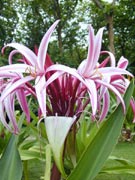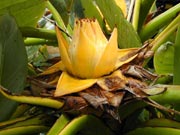|
Birth Tree of Buddha- Sorrowless Tree ( Saraca dives
Pierre)
Buddha Passed Away - Sal (Shorea obtusa Wall)
According to the Buddhist scriptures, the founder of Buddhism, Sakyamuni, always stay together with plants in critical moments of His lift: He was born under the sorrowless tree(Saraca sp.) dives Pierre of His external grandmother; He became a Buddha under the sacred fig
(Ficus religiosa) trees; and He died under the sal (Shorea sp.). Therefore, Buddhism has quite close relations with plants. According to the records of "the Birth Records of the 28th Generation of Buddha", Buddhism has altogether 28 generations of Buddhist masters; each master would rule 5000 years; and Sakyamuni is the 28th Buddhist master.
 |
|
St. Johns Lily |
The Buddhist temples of the Dai folks are big and high, and are resplendent and magnificent; and their construction styles were mainly evolved from the "flying phoenix" bamboo buildings. Special woods are needed for the construction of Buddhist temples, such as teak
(Tectona grandis), Chukrasia tabularis Var. velutina, malay bushbeech
(Gmelina arborea) and Paramichelia baillonii, which are all upright and hard woods, and at the same time mothproof. The wooden carvings in the Buddhist temples, such as the statues of Buddha, holy wares and holy animals, also must use woods such as
teak, Paramichelia baillonii, and jackfruit
(Artocarpus heterophylla) etc. The Buddhist lamps must use special oil extracted from special seeds of woods, such as ironwood
(Mesua ferrea) and candle nut (Aleurites moluccoulda) etc. When boys want to become monks or the monks need to be enhanced to higher ranks, they must first take a bath with water boiled with holy trees, holy beans and holy grasses, such as
Cinnamomum spp., rose apple
(Syzygium spp.) and Acacia rugata etc. Among the tributes for Buddha, there are fruits such as betelnut
(Areca catechu), banana (Musa nana), Ba Jiao (M.
sapientum) and flowers such as water lily (Nelumbo nucifera), candock
(Nymphaea lotus), St. Johns Lily (Crinum asiaticum var.
sinicum)and Hedychium chrysoleucum etc., as well as Ficus religiosaleaves cut from golden papers etc. The tributes must also be dyed into red, yellow and orange colors extracted separately from the roots of anatto tree
(Bixa orellana), Gardenia sootepense and medicinal indianmulberry root
(Morinda officinalis) etc.
 |
|
Hairyfruit Musella |
There is a yard encircled by low walls and bamboo fences in each Buddhist temple; their areas are different, and inside them, usually there are dozens or hundreds of plants. Among these plants, except some fruit trees planted for the monks, there must be the "trees of Buddha" and some usual plants used in Buddhist activities, as well as plants where the Buddhist scriptures are written on, such as talipot palm
(Coryphy um- braculifera) and papermulberry (Broussonetia
papyrifera) etc. Though the varieties of plants could be more or less in the yards, they must include the "five Buddhist trees and the six Buddhist flowers. The five trees include: banyan
(Ficus religiosa), council tree (Ficus altissima), talipot palm,betelnut,and plamyra palm
(Borassus spp.) Or coconut; and the six Buddhist flowers include: water lily,
Crinum asiaticum var. sinnicum, Hedychium chrysoleucum, Michelia
champaca, frangipani
(Plumeria rubra) and hairyfruit musella (Musella
lasiocarpa) etc. Among these trees and flowers, some are Buddhist trees and flowers, and the rest are plants necessary for worshiping the Buddha. It's said that the "five Buddhist trees and six Buddhist flowers" were promoted by a erudite Buddhist scholar. He told the folks that: the reason why Jinghong is beautiful is that, it has five kinds of trees and six kinds of flowers, as well as peacocks and elephants. The folks agree with him, therefore, the monks take the lead to plant these trees and flowers in temples, and they also raise peacocks. Afterwards, this custom is followed by all folks in Xishuangbannna, plus elephant and peacocks, they become the symbols of Xishuangbanna.
By doing this, the entire Buddhist temples become "gardens of Buddhist plants". In the recent years, the Tropical Botanical Garden of Xishuangbanna, in cooperation with the Buddhist temples, carried out researches on the Buddhist plant culture and they also applied the scientific results to the plants in Buddhist temples.
 
|

